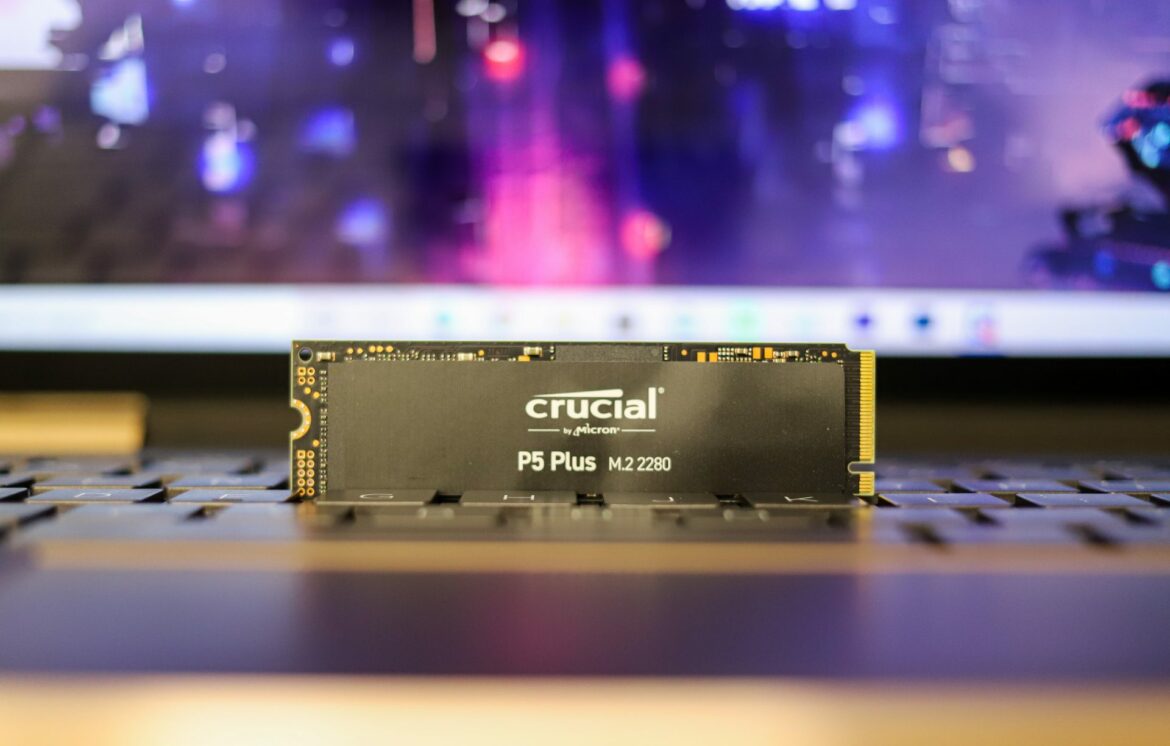The Crucial P5 Plus is the company’s first Gen4 SSD to hit the market. Though the P5 line is considered by the company as their more premium SSDs, it is actually more in line with the mainstream, budget-friendly category. Historically this affordable price tag comes at the expense of performance, and the new Plus model is no exception. That said, Crucial indicates that their new Gen4 drive is designed for a wide range of use cases, including professionals who need a viable solution for their heavy workloads as well as creatives photographers and videographers, gamers, and everyday consumers who want to make the jump to the new PCIe interface. It is available in capacities ranging from 500GB to 2TB.
The Crucial P5 Plus is the company’s first Gen4 SSD to hit the market. Though the P5 line is considered by the company as their more premium SSDs, it is actually more in line with the mainstream, budget-friendly category. Historically this affordable price tag comes at the expense of performance, and the new Plus model is no exception. That said, Crucial indicates that their new Gen4 drive is designed for a wide range of use cases, including professionals who need a viable solution for their heavy workloads as well as creatives photographers and videographers, gamers, and everyday consumers who want to make the jump to the new PCIe interface. It is available in capacities ranging from 500GB to 2TB.
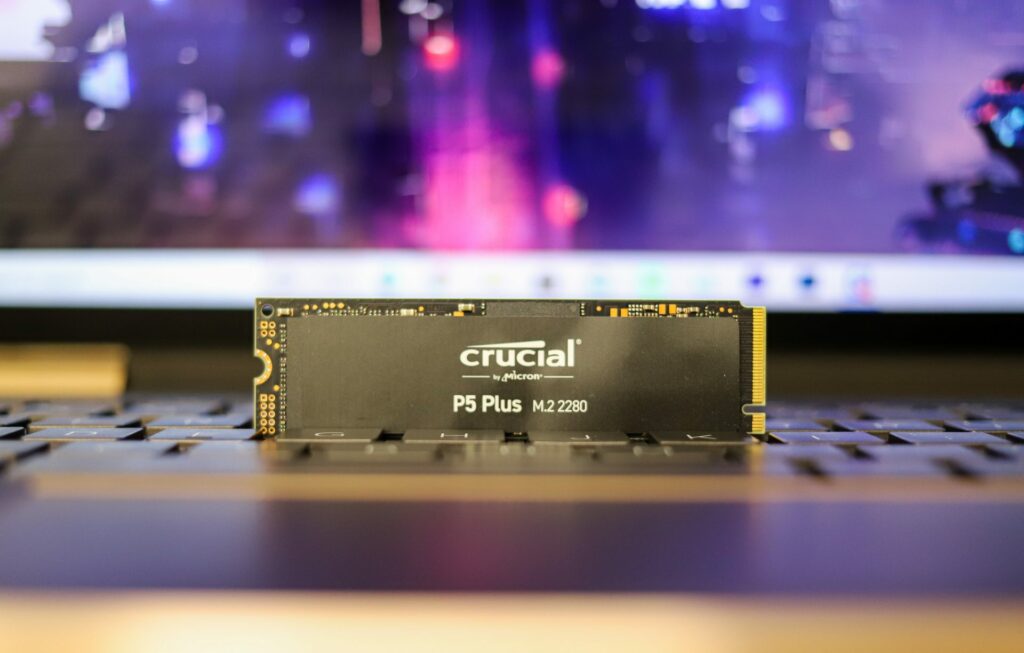 For performance, the P5 Plus is quoted with potential read and write speeds up to 6,600MB/s and 5,000MB/s, respectively. Crucial also focused on increased longevity and reliability with their new SSD, indicating an MTTF (mean time to failure) rating of over 2 million hours, which is a bit more than its predecessor, the Crucial P5 Gen3 SSD.
For performance, the P5 Plus is quoted with potential read and write speeds up to 6,600MB/s and 5,000MB/s, respectively. Crucial also focused on increased longevity and reliability with their new SSD, indicating an MTTF (mean time to failure) rating of over 2 million hours, which is a bit more than its predecessor, the Crucial P5 Gen3 SSD.

The P5 Plus also comes bundled with SSD management and Acronis Cloning software, which allows users to optimize performance based on their specific needs, increase data security, and easily upgrade the drive’s firmware. It also comes with a range of advanced features such as dynamic write acceleration (to help improve energy consumption and performance), multistep data integrity algorithm (for data loss protection), integrated power loss immunity (protects data during sudden power loss), and error correction code (so that a decoder can identify and correct errors in the data).
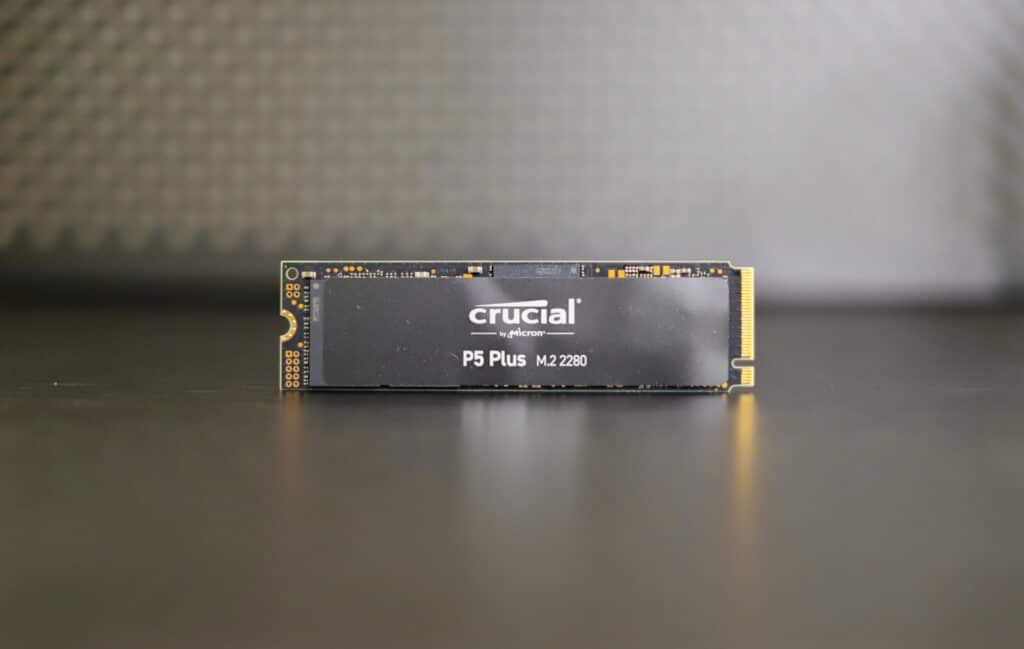
Backed by a 5-year warranty, the Crucial P5 Plus goes for roughly $108 (500GB), $180 (1TB), and $368 (2TB). We will be looking at the 1TB model for this review.
Crucial P5 Plus Specifications
| NAND | Micron Advanced 3D NAND |
| Capacities | 500GB, 1TB, 2TB |
| Interface | · PCIe 4.0 NVMe technology
· Gen3 backward compatibility |
| Form Factor | M.2 (2280) |
| Performance | · Read speeds up to 6600MB/s
· Write speeds up to 5000MB/s |
| Advanced features | · Dynamic write acceleration
· Redundant array of independent NAND (RAIN) · Multistep data integrity algorithm · Adaptive thermal protection · Integrated power loss immunity · Active garbage collection & TRIM support · Self-monitoring and reporting technology (SMART) · Error correction code (ECC) · NVMe autonomous power state transition (APST) · Full-drive encryption capable (TCG OPAL 2.0) |
| SSD Endurance (TBW) | 1,200TB |
| Warranty | 5-Years |
Crucial P5 Plus Performance
SQL Server Performance
Each SQL Server VM is configured with two vDisks: 100GB volume for boot and a 500GB volume for the database and log files. From a system resource perspective, we configured each VM with 16 vCPUs, 64GB of DRAM and leveraged the LSI Logic SAS SCSI controller. While our Sysbench workloads tested previously saturated the platform in both storage I/O and capacity, the SQL test is looking for latency performance.
This test uses SQL Server 2014 running on Windows Server 2012 R2 guest VMs and is stressed by Quest’s Benchmark Factory for Databases. StorageReview’s Microsoft SQL Server OLTP testing protocol employs the current draft of the Transaction Processing Performance Council’s Benchmark C (TPC-C), an online transaction-processing benchmark that simulates the activities found in complex application environments.
The TPC-C benchmark comes closer than synthetic performance benchmarks to gauging the performance strengths and bottlenecks of storage infrastructure in database environments. Each instance of our SQL Server VM for this review uses a 333GB (1,500 scale) SQL Server database and measures the transactional performance and latency under a load of 15,000 virtual users.
SQL Server Testing Configuration (per VM)
- Windows Server 2012 R2
- Storage Footprint: 600GB allocated, 500GB used
- SQL Server 2014
- Database Size: 1,500 scale
- Virtual Client Load: 15,000
- RAM Buffer: 48GB
- Test Length: 3 hours
- 2.5 hours preconditioning
- 30 minutes sample period
Looking at SQL Server average latency, the Crucial P5 Plus had an average latency of 103ms, which placed it at the very bottom of the leaderboard by a significant margin (right beside the Samsung 980).
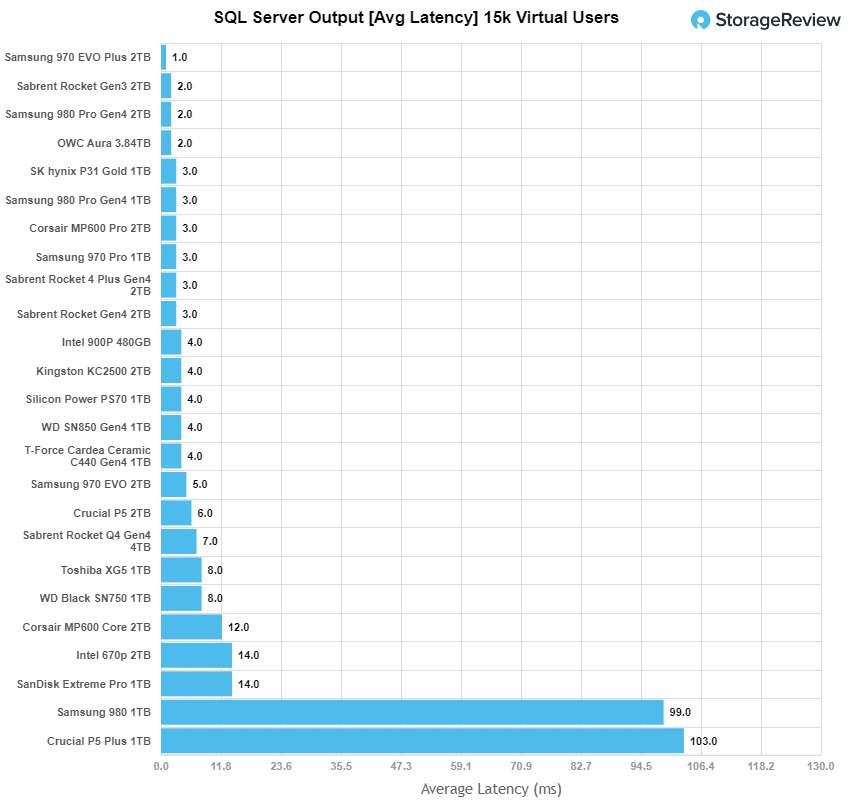
VDBench Workload Analysis
When it comes to benchmarking storage devices, application testing is best, and synthetic testing comes in second place. While not a perfect representation of actual workloads, synthetic tests do help to baseline storage devices with a repeatability factor that makes it easy to do apples-to-apples comparison between competing solutions. These workloads offer a range of different testing profiles ranging from “four corners” tests, common database transfer size tests, to trace captures from different VDI environments.
All of these tests leverage the common vdBench workload generator, with a scripting engine to automate and capture results over a large compute testing cluster. This allows us to repeat the same workloads across a wide range of storage devices, including flash arrays and individual storage devices. Our testing process for these benchmarks fills the entire drive surface with data, then partitions a drive section equal to 5% of the drive capacity to simulate how the drive might respond to application workloads. This is different than full entropy tests which use 100% of the drive and take them into a steady state. As a result, these figures will reflect higher-sustained write speeds.
Profiles:
- 4K Random Read: 100% Read, 128 threads, 0-120% iorate
- 4K Random Write: 100% Write, 64 threads, 0-120% iorate
- 64K Sequential Read: 100% Read, 16 threads, 0-120% iorate
- 64K Sequential Write: 100% Write, 8 threads, 0-120% iorate
Comparables
- Sabrent Rocket NVMe SSD 4.0 2TB
- Sabrent Rocket 4 Plus SSD
- Silicon Power US70 PCIe 4.0 SSD 1TB
- T-Force Cardea Ceramic C440 1TB
- XPG GAMMIX S70 SSD
- Samsung 980 Pro 1TB
- Samsung 980 Pro 2TB
- Phison PS5018-E18
In 4K random read, the Crucial P5 Plus started things off with mid-range results, boasting a peak performance of 393,061 IOPS and a latency of 323.5µs.
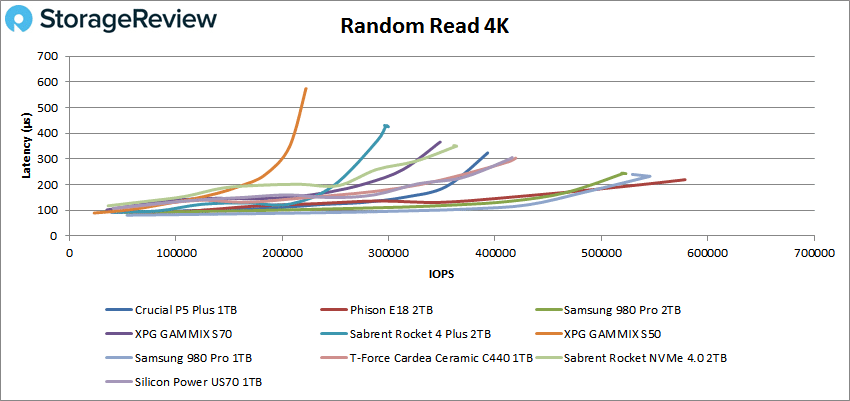
For 4K write, the Crucial P5 Plus remained in the middle of the leaderboard (though well back of the leaders) with a peak of 207,968 IOPS with a latency of 609.6µs before dropping off in performance a bit.
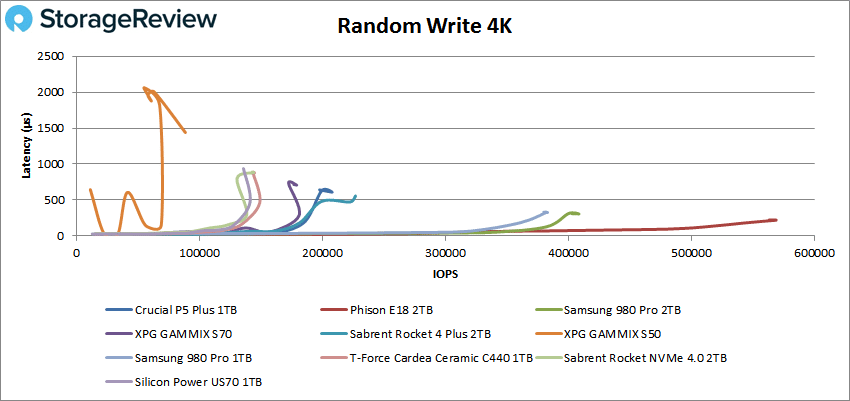
Switching to sequential workloads we look at our 64K tests. In read, the Crucial P5 Plus fell back to second last place with 52,493 IOPS or 3.26GB/s with a latency of 608.5µs.
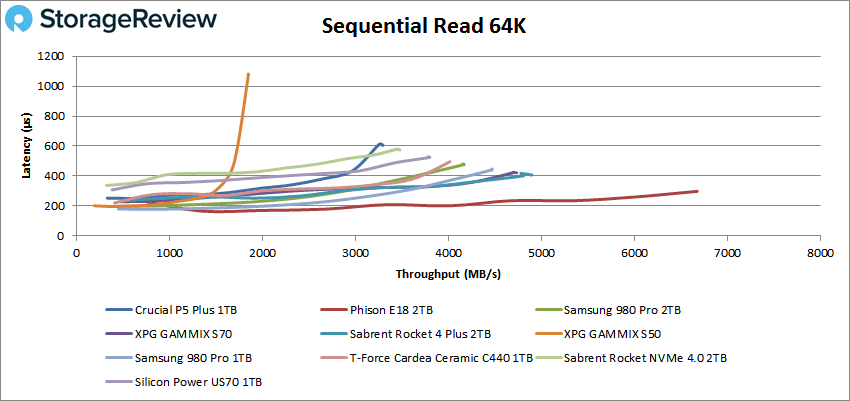
In 64K writes, the P5 Plus placed 4th, posting a peak score of 19,675 IOPS or 1.23GB/s at a latency of 805.5µs.
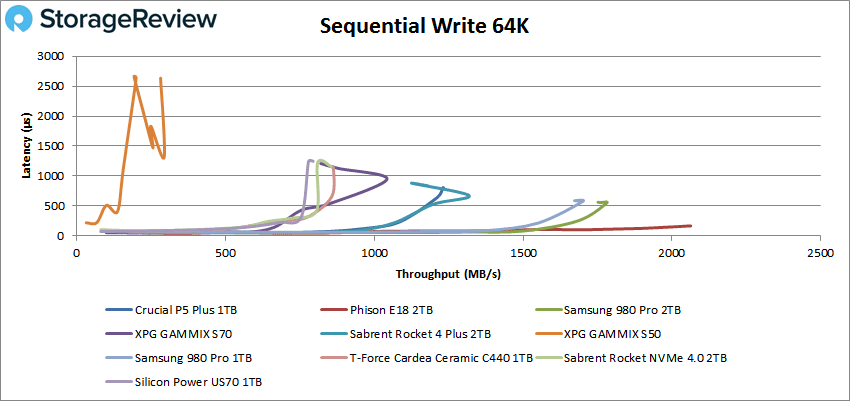
Next, we looked at our VDI benchmarks, which are designed to tax the drives even further.
Unfortunately, the Crucial P5 Plus failed during multiple tries with our VDI benchmarks, all of which are designed to tax the drives even further. We managed to get the Gen4 drive to work for the VDI’s Boot test; however, it would fall out and go offline during Monday and Initial login tests. We re-tried it several times and could not get it to work without fail. This was a surprising first for us. The only way to make the drive re-appear in the system was through a full power cycle. At the start of the test in question, it would immediately go offline within 10 seconds of that specific workload being applied.
That said, in Boot, the Crucial P5 Plus had a peak of just 48,897 IOPS with a latency of 718.8µs, which was well behind the other drives, especially in latency. As you can see from the chart below, once it hit 40,000 IOPS, it started to slow down.
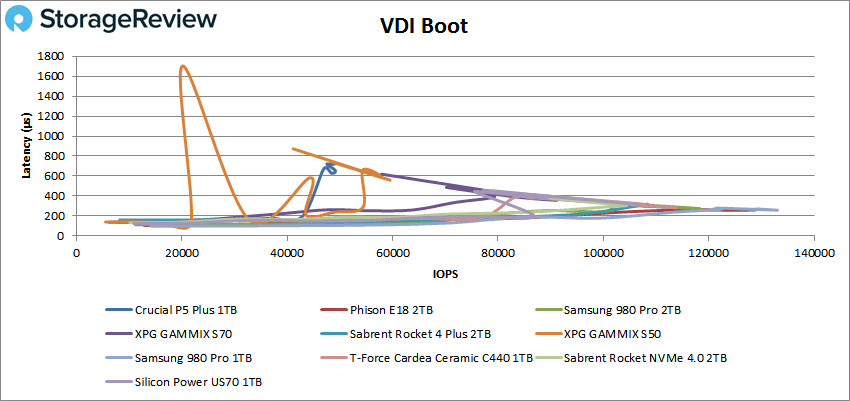
Conclusion
The Crucial P5 Plus is the “upgraded” version of the company’s NVMe SSD line. It features the new Gen4 interface, Micron’s Advanced 3D NAND/controller, and is designed for pretty much anyone (says Crucial): professionals, creatives, gamers, and consumers who want to take advantage of their new Gen4-supported motherboard. It also comes in capacities ranging from 500GB to 2TB and is equipped with a range of advanced features like Dynamic write acceleration, Adaptive thermal protection, Error correction code, and full-drive encryption support.
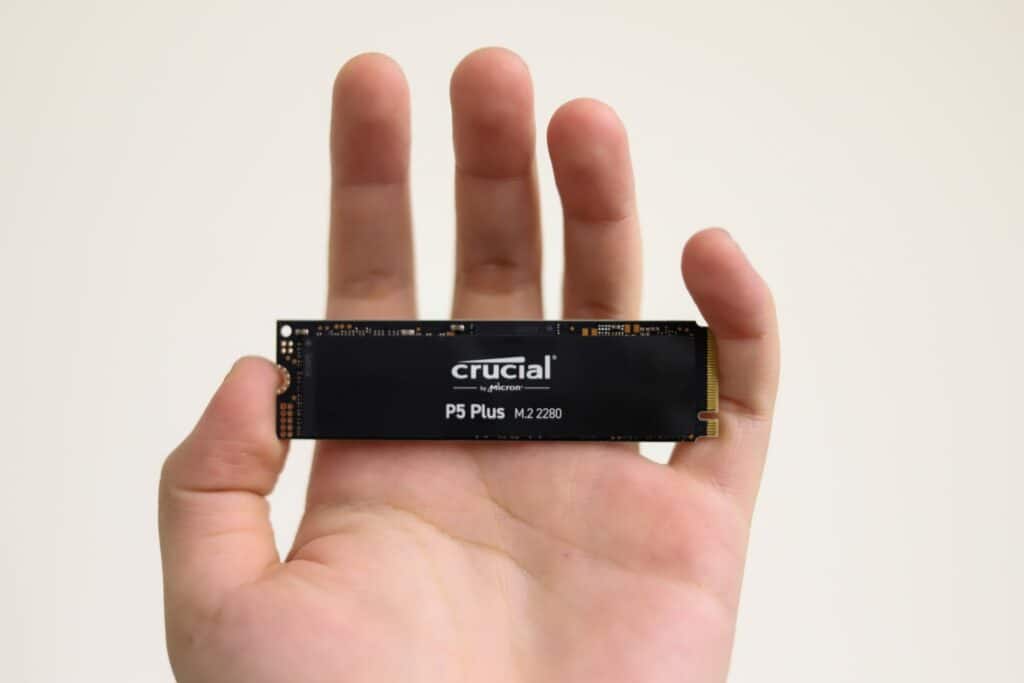
That said, while Crucial touts their drive as an ideal solution for intensive workloads (while being considered by the company as one of its premium SSDs), it certainly did not demonstrate this during our tests. For example, it showed mediocre 4K performance and fell back even more during the 64K sequential reads/writes. And, out of the three VDI benchmarks, it was only able to complete our boot test, as it failed during the Initial login and Monday tests. This was the first time we’ve reviewed a drive that was unable to make it through.
Highlights include: 393,061 IOPS in 4K read, 207,968 IOPS in 4K write, 3.26GB/s in 64K read, and 1.23GB/s in 64K write. In our VDI boot (the lone test that it survived), we saw just 48,897.
The P5 Plus is indeed a noticeable improvement over the original Crucial P5 in the tests that it was actually able to complete; however, results were sub-par to mediocre when compared to other tested Gen4 drives. Its affordable price tag doesn’t really make up for the lack of performance, as Crucial should really further drive down the cost to make this a worthwhile budget purchase. Compared to other Gen4 drives like the superior Samsung 980 Pro and Sabrent Rocket 4 Plus, which retails around $200/$200 (1TB) and $396/$470 (2TB), the P5 Plus goes for roughly $180 (1TB) and $368 (2TB). So, if you’re willing to spend a little bit more for a much better drive, it might be in your best interest to do so.
Engage with StorageReview
Newsletter | YouTube | LinkedIn | Instagram | Twitter | Facebook | TikTok | RSS Feed

